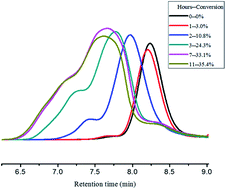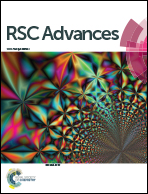Synthesis of pH-responsive amphiphilic branched macro-RAFT agent and the application in surfactant-free emulsion polymerization†
Abstract
Branched polymers have obviously different physical properties from their linear analogues such as low viscosity, high solubility, uncommon rheological properties and large amounts of functional groups. A series of branched poly(methyl acrylate)-block-poly(acrylic acid)s (PMA-b-HBPAAs) and branched poly(acrylic acid)-block-poly(methyl acrylate)s (PAA-b-HBPMAs) were successfully synthesized via RAFT polymerization using polyethylene glycol dimethacrylate (PEGDMA) as a branching agent, followed by a hydrolysis reaction. The structure of the branched copolymer was confirmed by Gel Permeation Chromatography (GPC), proton nuclear magnetic resonance (1H NMR) and Fourier transform infrared spectrometry (FT-IR). Then the emulsifying performance and pH responsive behavior of these amphiphilic branched macromolecules were investigated. Furthermore, these amphiphilic branched macromolecules were used as surfactants and polymerization mediators for emulsion polymerization of styrene (St) at two pH (5.5 and 12.6), respectively. Due to the balanced hydrophilicity and hydrophobicity, PMA80-b-HBPAA120 proved to be an efficient surfactant both at pH = 12.6 and pH = 5.5. The influence of the pH, the length of the hydrophilic block of the PAA segments and hydrophobic PMA segments of the amphiphilic branched macromolecule have been studied.


 Please wait while we load your content...
Please wait while we load your content...